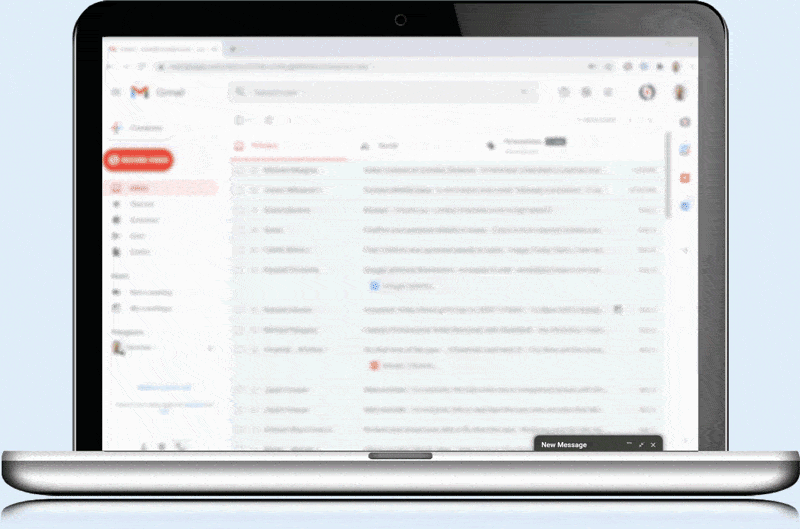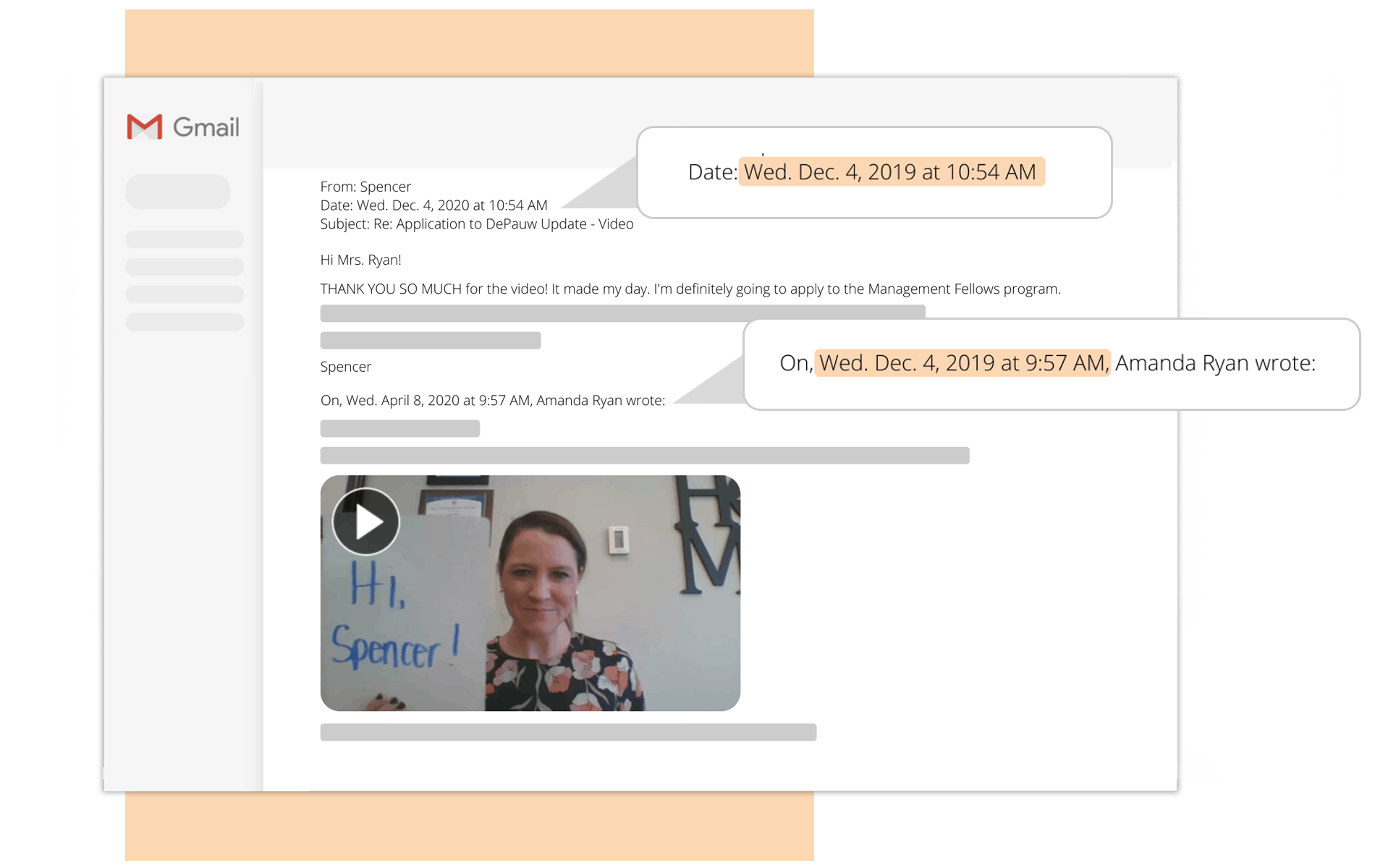How to attract prospective students to your college
Colleges & universities use personalized video to transform outreach, increase engagement, and leave a lasting impression on students.







Recruiting college students virtually
Record and deliver hyper-personalized video messages that reach and resonate with prospective students, making them feel recognized and connected to your school from the first interaction.
What is Covideo?
Covideo is a tool that lets you easily record, send and track videos for a dynamic, hyper-personalized message that has the benefits of face-to-face conversations, with the flexibility and convenience of email and text.
Admissions
Increase yield and fight melt by adding video into your recruitment outreach. Creating a highly personalized experience for each student allows you to establish a genuine connection from the start, and has shown to shorten response times, while increasing engagement.


Advancement
Keep alumni and other stakeholders engaged with personalized messages, increasing their sense of community with the school. This makes them more likely to get involved, stay involved, and offer their continued support.
Student Success
Improve student retention and satisfaction. 70% of students are likely to stay on campus if someone at your school knows their name or has a personal connection with them. Make students feel seen and let them know their success is important by incorporating video into advising and the classroom.

Use cases
Admissions
- Invitations/reminders
- Follow ups
- Sharing good news
- Suggestions on how to get involved
- Introducing faculty & student body
Advancement
- Giving campaigns
- Invitations/announcements
- Thank yous
- Collect and share student impact stories
Student Success
- Advising
- Early alert system
- Personal communication from faculty/staff
- Classroom application
How to Attract Prospective Students to Your College
If you are a college or private school, you need to be doing everything you can to attract prospective students online. Due to both the rise of communication technology and the global pandemic, students connections with universities, brands, and each other is changing drastically. If you want to reach top-tier students, you need to be doing all you can to stand out from the crowd.
In this article, we will go in-depth into what you can do to attract prospective students. This article is primarily for admissions officers at colleges and universities, though private and boarding schools can also apply this information.
First, we will discuss what is a prospective student and how prospective students act in 2022. Then, we will go over what prospective students are looking for in a school and the best ways to reach out and appeal to students. Finally, we will discuss how you can use Covideo’s video email platform to send personalized messages to prospective students so you can both widen your reach and have more in-depth communication with prospective students.
What is a Prospective Student?
So, what is a prospective student? A prospective student is a person who is in the process of applying for college but has yet to commit to a specific school. They are people who are interested in attending your school but aren’t sold on it.
Many prospective students are high school seniors, but some are transfer students or non-traditional students looking for a new school or ready to start a degree later in life. About 10% of US college students are over 40! Prospective students come from a variety of economic, educational, and generational backgrounds.
If you work from a private primary or secondary school, you may also interact with prospective students and their parents. In 2017, approximately 5.7 million students were enrolled in a private primary or secondary school. When trying to target these students, you may compete against other private schools and public or charter schools. You also need to convince both the students and parents that your school is the best fit! As such, you need to use tools that appeal to both children and adults.
As you can see, prospective students are a diverse bunch. They have different needs and experiences. So how do you appeal to such a wide range of students?
What Are Prospective Students Looking For?
Though prospective students are diverse, there are still some common characteristics and needs among them. To put it simply, prospective students are looking for quick answers to the questions they have about your institution. These questions are usually centered around the following four topics:
Cost and financial aid
Approximately 83% of prospective students anticipate having at least some difficulty paying for college, and about 16% say that paying for college will be extremely difficult. Unsurprisingly, almost all students, regardless of background, want information about tuition and financial aid.
You need to communicate with students about how your institution is affordable and worth the cost. Provide specific information about financial aid, work-study programs, and scholarships. Better yet, use methods that respond to each students’ individual needs, such as a pricing calculator or meeting with a financial aid specialist.
Academic programs
Students are going to your college to learn and get a degree in their field of interest. So, of course, prospective students want information about your academic program! In general, prospective students are more interested in looking up specific information about available majors and minors than general academic rankings. According to a study by EAB, 70% of prospective students search a college’s website for information about majors and minors, while only 19% looked for information about a school’s ranking or reputation.
So, students want to know more about how your school can fit their specific plans than about your reputation. As such, you need to make sure information about specific majors and minors is readily available in your prospective student materials. When reaching out to prospective students, find out about their specific academic interests, and try to pull in some faculty or current students to promote specific majors or departments!
Job prospects
Most students go to college so that they can get the job that they want. Over 50% of students choose an institution because its graduates get good jobs. What defines a “good job” varies, but in general, you want to clarify to students that their degree is valuable in the work world and that they will find a stable, well-paying job after graduation.
Because of this, you should share specific success stories targeted to the prospective student’s major or desired career. Ask alumni for their stories and find those that are willing to talk with students. You should also make information from your college’s career development office readily available. Students want to know that their college will help them find a job when the time comes to graduate. Make it clear that your institution cares about the success of students even after they leave.
Student life
Finally, you want to make sure prospective students understand that your college will provide a good, healthy environment for them. Students want to attend a college that not only betters their minds and job prospects but also betters their life while they’re attending. Students, quite simply, want to be happy at their college (or private school) of choice.
As such, you should be ready and willing to answer questions about various topics related to student life, such as clubs and organizations, student activities, residence halls, and meal plans. Even if your school is in-part or entirely online, you can still answer questions students have about remote events and opportunities to connect with other students.
How to Contact Prospective Students
So, what’s the best way to communicate with prospective students and answer the above questions and concerns? Once again, because prospective students are a diverse bunch, there is no one correct answer to how you should contact them. You should always use several platforms and methods to make yourselves available to prospective students. However, some general trends have been identified in terms of how prospective students most like to communicate with the schools they’re interested in and which methods are the most effective.
Before delving into communication methods, let’s talk briefly about the elephant in the room. The ongoing Covid-19 pandemic has drastically changed how colleges can communicate with students. In the past, college tours and admitted student visits were a significant part of the admissions process. However, because of the pandemic, your institution may not be able to hold college tours and visits, and many prospective students cannot travel to attend such events.
As such, admissions counselors must change their strategy and focus more on online recruitment efforts. This shift can be tricky, but thankfully there is already infrastructure in place that can be used to communicate effectively with prospective students online.
Email
In terms of the most effective online strategies for attracting prospective students, email is #1. In a survey that asked prospective students how they preferred colleges to initiate communication with them, 50% of respondents chose email. Your emails to students should be personalized and focus on the information they want instead of the information you want to give them. Focus on the topics listed above: financial aid, academic programs, job prospects, and student life.
An example email sent to prospective students from Kenyon College
The above email example is from 2012 but still provides an excellent example of how to reach out to and inform prospective students. The email newsletter from Kenyon College offers information about financial aid, admissions deadlines, and graduate success stories in small, bite-size form. Since the average person’s attention span is only 8 seconds, it’s crucial to convey information in short sentences, phrases, and images.
Whether or not Kenyon’s email campaign was successful is not information that this author has, but I can confirm that it worked on me!
Social media
McGill University uses Instagram to answer prospective student questions
Unsurprisingly, social media is another tool popular with prospective students. Instagram and TikTok are especially popular among Gen-Z prospective students. Social media presents the perfect opportunity to widen your reach and use bite-size media to appeal to students. You can use social media to show off your school’s campus and classes, while prospective students cannot book on-campus tours.
However, you want to make sure your social media comes across as personable. Students sometimes find that college social media accounts come across as “fake and disingenuous.” The best way to avoid this is to put students or recent college graduates in charge of social media instead of administrators. Nobody knows how to appeal to prospective students like your own students who have their own college admissions process fresh in their mind. Your students know better than you how to make a post or video go viral. Let them help you create and market content for your school.
Video
Video is a prevalent communication format. Prospective students, especially those who are part of Gen Z, can be found on YouTube, Snapchat, TikTok, and Instagram watching videos about the colleges they’re interested in. Video is handy during the global pandemic as colleges can use videos to show parts of the campus currently closed to prospective students. Short videos that are a minute or two in length are a great way to introduce students to your school and invite them to seek more information by contacting an admissions counselor or current student.
Nonetheless, you need to make sure your videos look and feel professional. Videos should be both informational and aesthetically pleasing. You can use edited video footage or still images to create attractive videos that prospective students want to watch. With so much video content available on the web today, you need to make sure your videos stand out in terms of quality and focus.
So, in sum, if you’re part of a college admissions team, you need to be using email, social media, and video to appeal to students in addition to traditional snail mail and campus visits. But what if you could combine two of the most popular communication formats? That’s where video email comes in.
Use Video Email to Reach Out to Prospective Students
What is video email?
Video email is a form of email that embeds video directly into the body of an email. With video email, you can include videos in your email messages to prospective students, thus combining two popular media forms into one top-tier student recruitment strategy.
You can use a video email platform like Covideo to add video to email with ease. Using Covideo for desktop or mobile, you can record videos using your device’s screen, webcam, or both. Then, you can embed your recorded video directly into an email or text message. (You can also upload already-recorded videos to the Covideo platform to include in a message!). Your video will appear as an animated GIF in the body of the email. Then, when your recipient clicks on the email, they will be redirected to a custom landing page of your choice where they can watch the full video.



